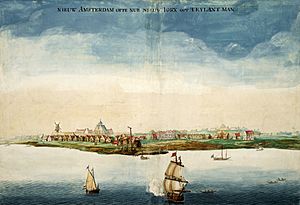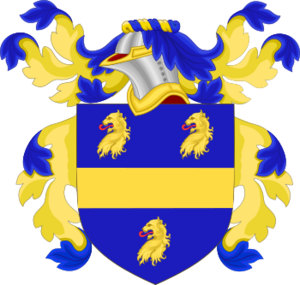Richard Nicolls facts for kids
Quick facts for kids
Richard Nicolls
|
|
|---|---|
| 1st Colonial Governor of New York | |
| In office September 1664 – Summer 1668 |
|
| Monarch | Charles II |
| Preceded by | Peter Stuyvesant (as Director-General of New Netherland) |
| Succeeded by | Francis Lovelace |
| Personal details | |
| Born | 1624 Ampthill, Bedfordshire, England |
| Died | 28 May 1672 (aged 47–48) North Sea, off Suffolk |
| Relations |
|
| Parents |
|
| Signature | |
Richard Nicolls (sometimes spelled Nichols) was an important English leader. He became the first English governor of New York province. He was born in 1624 and died in 1672. He helped England take control of a part of America from the Dutch.
Contents
Early Life of Richard Nicolls
Richard Nicolls was born in 1624 in a town called Ampthill in Bedfordshire, England. His father, Francis Nicolls, was a lawyer and a member of Parliament. His mother was Margaret Bruce. Her father, Sir George Bruce, was a Scottish merchant who built a famous building called Culross Palace.
Nicolls' Career and Public Service
Richard Nicolls was a soldier who fought for the king during the English Civil War. When the king's side lost, Nicolls had to leave England for a while. After the king returned to power, Nicolls became a special assistant to the Duke of York.
Taking Control of New York
In 1664, the Duke of York chose Nicolls for a very important job. He was part of a group sent to take over New Netherlands from the Dutch. This area is now New York. The group also had to help settle problems in the English colonies in New England.
The expedition sailed from England on May 25, 1664. They arrived at New Amsterdam (which is now New York City) on August 27, 1664. The Dutch leaders gave up control of New Amsterdam to Nicolls on September 8, 1664. After this, Nicolls became the deputy-governor of the new English territory, which was renamed New York.
Nicolls made 74th Street the southern border of the village of Nieuw Haarlem. The English also renamed this village "Lancaster," but it is now known as Harlem.
Governing the New Colony
Nicolls was a strong leader, but he was also very fair and smart. He made the change from Dutch to English rule smooth for everyone. The Dutch colonists were allowed to keep their property and their laws about inheritance. They also kept their religious freedom.
The English legal system was quickly started in places like Long Island, Staten Island, and Westchester. These areas already had many English settlers. However, Nicolls made changes more slowly in the areas where most people were Dutch.
Nicolls created a set of laws called the "Duke's Laws." He wrote these laws with the help of his nephew, Matthias Nicolls. These laws were announced on March 1, 1665, in Hempstead, Long Island. They stayed in use until 1683. The laws included things like trial by jury and fair taxes on property. They also made sure that land ownership was approved by the Duke.
Return to England and Death
Richard Nicolls went back to England in the summer of 1668. He continued to work for the Duke of York. Another governor, Francis Lovelace, took his place in New York.
Nicolls was killed in a naval battle called the Battle of Southwold Bay on May 28, 1672. His memorial in Ampthill includes the cannonball that killed him.



